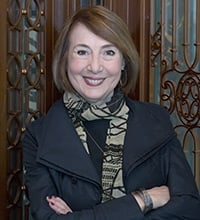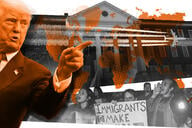You have /5 articles left.
Sign up for a free account or log in.

Cathy N. Davidson
City University of New York
When it comes to ideas, bigger is definitely better for Cathy N. Davidson. During her more than 20 years at Duke University, Davidson held two endowed professorships, in English and interdisciplinary studies, and wrote prolifically on the intersections of technology, education, work and culture. A pioneering digital humanist, she also co-founded the Humanities, Arts, Science and Technology Alliance and Collaboratory to connect academics, artists and technologists around issues of pedagogy (the group’s motto is “Changing the way we teach and learn”).
On top of that, Davidson is a lead researcher for the collaboratory and John D. and Catherine T. MacArthur Foundation Digital Media and Learning Competitions to support pedagogical innovations around the world. Talking to Davidson about any one of these endeavors or others too numerous to mention here is like sitting in on a class on the utopian future of higher education – one without disciplinary limits or practical boundaries. City streets become classrooms, all data matter, and students teach as much as they learn. And if you can keep up with the heavy doses of theory, from Frederick Winslow Taylor on scientific management to Paulo Freire on critical pedagogy, it’s mind-bending and kind of beautiful: imagine Christopher Nolan’s 2010 film “Inception,” with a higher education slant.
But Davidson’s newest idea, the Futures Initiative at the Graduate Center of the City University of New York, might just be her biggest yet. This summer, she was lured away from Duke by the Graduate Center to do something truly unique, on a grand scale: foster interdisciplinary and collaborative teaching and learning across the CUNY system, in a way that inspires reinvestment in public higher education.
Davidson loved Duke, but the chance to do something bold that could trickle down into a system as big as CUNY, with some 250,000 students, was something she couldn’t pass up – a once-in-a-lifetime opportunity, she said in an interview.
“I would say it was a perfect meeting of the minds,” Davidson said, noting that seeds for the Futures Initiative were planted a couple of years ago, when she kicked off a tour for her book, Now You See It: How Technology and Brain Science Will Transform Schools and Business for the 21st Century, at the Graduate Center. Then-President William Kelly introduced her; the two talked and discovered they shared many of the same views about the future of higher education. So later, when Davidson’s name was on a short list for a college presidency (she didn’t say which), she called Kelly to ask what he thought.
Namely, Davidson said she wanted to know if it was possible to champion the kinds of ideas she has throughout her career and still be an effective president. While Kelly confirmed some of her “misgivings,” she said, he also pulled “a switch I didn’t expect. He said, ‘Why don’t you come here instead, and make what you most want to do -- working to transform higher education from the classroom outward to [effect] massive institutional change?’ ”
She continued: “We talked about what that would look like, the massive scale, how exciting [it would be] to model transformation at the nation’s largest, public urban university, one where access and quality go hand-in-hand.”
That was in the spring of 2013; the CUNY Futures Initiative -- of which Davidson is the director -- is now in its inaugural year. It seeks to promote innovative pedagogies with an eye on peer-to-peer learning. This semester, her first at CUNY, Davidson is hosting a series of workshops on innovative teaching, learning, scholarship and publication. Topics so far include, “What is a Dissertation? New Models, Methods, Media.” It centered on nontraditional dissertations -- such as one on comics that was told in comics -- and was by all accounts a success. Presented with a series of institutional partners worldwide, the workshop’s Twitter tag, #remixthediss, was retweeted so many times it started trending, Davidson said.
So far, the Futures Initiative is laying its groundwork -- and much remains to be seen in terms of what it ultimately accomplishes. But it'll kick up a gear or two at least next semester, when Davidson teaches a class with Kelly, who recently ended his stint as interim chancellor of the CUNY system. It's called "Mapping the Futures of Higher Education." The vision for the course is to take up to 15 graduate students in as many fields and have them propose pedagogical innovations to share with each other and to test out in their own undergraduate classrooms. Because so many of CUNY’s undergraduate courses are taught by graduate students, the trickle-down effect of the laboratory environment will be immediate.
On a dedicated website, the approximately 300 immediately affected undergraduate students will be able to comment and offer feedback on the project, “with a voice that goes right up to the chancellor,” Davidson said. “It’s incredible, really.” This year’s pilot graduate students will be the mentors for next year’s group, and additional workshops and feedback loops are planned.
In addition to the workshops and courses, the initiative is building what Davidson called a “public, interactive CUNY map of New York City.” Students' data will be anonymized for safety and privacy (much of Davidson’s scholarship centers on the topic of trust), but they’ll be able to “present” themselves digitally as part of a massive online network of CUNY students and New York City residents. Davidson called the project “a cartography of participation, creativity and innovation,” an open platform on which students can share resources and learn project management and digital literacy.
New York-centric
Both New York City and the CUNY mission loom large in Davidson’s vision for the Futures Initiative; to hear her describe it, it’s almost impossible to imagine it taking place anywhere else.
“I have joked before that the [Graduate Center] is my ‘crush school,’ ” she said -- a feeling that's only grown since she arrived. “New Yorkers have no idea what a gem they have here. In the city with the nation’s greatest income inequality, nearly 85 percent of our CUNY students graduate free of tuition debt. Educational equality in the city of extreme income equality – that should be on every sign in the city. ‘Yes, it costs a lot to live here -- but in this city your kid can go to college practically debt-free.’ Amazing.”
All that is only the beginning, Davidson said. Going forward, she hopes that the Futures Initiative will be able to explore and model a variety of big ideas about teaching and learning.
One of those ideas is that technology alone is not a panacea for what ails higher education. Educators needs to think “with, through and about” 21st-century interactive and connective technologies, just as educational reformers did during the Industrial age, Davidson said. But “this is not a top-down imposition of technology or massive online courses.” Rather, educators must strive to create “peer-driven, interdisciplinary, interactive, project- and problem-based new modes of learning, with appropriate new modes of assessment that match our world" -- and the multitude of ways it’s been changed by the internet.
Davidson added: “Right now we are being driven by [pedagogical] systems designed for the era of the Model T.”
If that sounds like a tall order, it is, and Davidson admitted that institutions take a “long time” to change. But, she said, “we can change what we do in our classrooms tomorrow. We can make meaningful learning experiences right now” – hence the Futures Initiative’s focus on peer-to-peer pedagogy.
Another key idea Davidson seeks to promote through the initiative is that successful innovation is best modeled by “those who are the primary stakeholders" -- students and faculty, not outside actors. “We need to get past the cynicism of thinking that venture capitalists who have no experience in education somehow magically know what is best for education,” she said, noting that many executives outside of higher education feel constrained in their ability to innovate because of “quarterly accounting to their shareholders.”
For that reason, she said, business executives "are not in a structurally advantageous position to think about transforming higher education for the good of students and faculty. Profit for someone else won’t save costs for taxpayers or tuition payers.” Sufficient to say, Davidson doesn't think that for-profit education companies and the legislators who sometimes champion them are best-suited to get higher education where it needs to go.
Lastly and perhaps most importantly, Davidson said, “quality and access not only can go together but must. A system that only admits the privileged is impoverished. Everyone learns better when systems are open. Everyone is shortchanged when learning happens only among those who share the same background and same values.” To that end, Davidson added, “We have to reinvest in public education as a civic and social good -- and that means in supporting the next generation of college professors more adequately. You cannot have quality education with a professoriate whose future is ‘contingent.’ ”
They’re all big – and somewhat daunting – ideas, and time will tell how big an impact the Futures Initiative has on teaching and learning at CUNY and higher education in general. But Davidson said her favorite thing about the initiative so far is the “optimism” at CUNY and the palpable feeling that “change is possible.”
“Public education is so beleaguered but the state and city of New York still fund CUNY in a way that other public, urban systems can envy,” she said.





